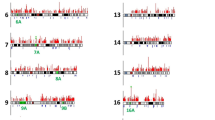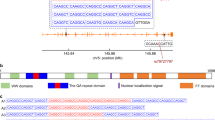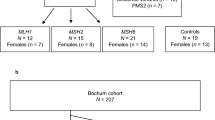Abstract
The initial observation of an expanded and unstable trinucleotide repeat in the Huntington's disease gene has now been confirmed and extended in 150 independent Huntington's disease families. HD chromosomes contained 37–86 repeat units, whereas normal chromosomes displayed 11–34 repeats. The HD repeat length was inversely correlated with the age of onset of the disorder. The HD repeat was unstable in more than 80% of meiotic transmissions showing both increases and decreases in size with the largest increases occurring in paternal transmissions. The targeting of spermatogenesis as a particular source of repeat instability is reflected in the repeat distribution of HD sperm DNA. The analysis of the length and instability of individual repeats in members of these families has profound implications for presymptomatic diagnosis.
This is a preview of subscription content, access via your institution
Access options
Subscribe to this journal
Receive 12 print issues and online access
$209.00 per year
only $17.42 per issue
Buy this article
- Purchase on Springer Link
- Instant access to full article PDF
Prices may be subject to local taxes which are calculated during checkout
Similar content being viewed by others
References
Martin, J.B. & Gusella, J.F. Huntington's disease: Pathogenesis and management. New Engl. J. Med. 315, 1267–1276 (1986).
Merrit, A.D., Conneally, P.M., Rahman, N.F. & Drew, A.L., Juvenile Huntington's chorea. In Progress in neurogenetics (eds Barbeau A. & Brunette, J.R.) 645–650 (Excerpta Medica, Amsterdam, 1969).
Bird, E.D., Caro, A.J. & Pilling, J.B. A sex related factor in the inheritance of Huntington's chorea. Ann. hum. Genet. 37, 255–260 (1974).
Huntington's Disease Collaborative Research Group. A novel gene containing a trinucleotide repeat that is expanded and unstable on Huntington's disease chromosomes. Cell 72, 971–983 (1993).
Gusella, J.F. et al. A polymorphic DNA marker genetically linked to Huntington's Disease. Nature 306, 234–238 (1983).
Wexler, N.S. et al. Homozygotes for Huntington's disease. Nature 326, 194–197 (1987).
Folstein, S.E. et al. Huntington's Disease: Two families with differing clinical features show linkage to the G8 probe. Science 229, 776–779 (1985).
MacDonald, M.E. et al. The Huntington's disease candidate region exhibits many different haplotypes. Nature Genet. 1, 99–103 (1992).
MacDonald, M.E. et al. Recombination events suggest possible locations for the Huntington's disease gene. Neuron 3, 183–190 (1989).
Pritchard, C. et al. Recombination of 4p16 DNA markers in an unusual family with Huntington disease. Am. J. hum. Genet. 50, 1218–1230 (1992).
Meissen, G.J. et al. Predictive testing for Huntington's disease with use of a linked DNA marker. New Engl. J. Med. 318, 535–542 (1988).
Brandt, J. et al. Presymptomatic diagnosis of delayed-onset disease with linked DNA markers: The experience in Huntington's disease. J. Am. med. Assoc. 261, 3108–3114 (1989).
Suthers, G.K., Huson, S.M., & Davies, K.E. Instability versus predictability: the molecular diagnosis of myotonic dystrophy. J. med. Genet. 29, 761–765 (1992).
Fu, Y.H. et al. Variation of the CGG repeat at the fragile X site results in genetic instability: resolution of the Sherman paradox. Cell 67, 1047–1058 (1991).
Kremer, E.J. et al. Mapping of DNA instability at the fragile X to a trinucleotide repeat sequence p(CCG)n. Science 252, 1711–1714 (1991).
Verkerk, A.J.M.H. et al. Identification of a gene (FMR-1) containing a CGG repeat coincident with a breakpoint cluster region exhibiting length variation in fragile X syndrome. Cell 65, 904–914 (1991).
Yu, S. et al. Fragile-X syndrome: unique genetics of the heritable unstable element. Am. J. hum. Genet. 50, 968–980 (1992).
Brook, J.D. et al. Molecular basis of myotonic dystrophy: expansion of a trinucleotide (CTG) repeat at the 3′ end of a transcript encoding a protein kinase family member. Cell 68, 799–808 (1992).
Aslanidis, C. et al. Cloning of the essential myotonic dystrophy region and mapping of the putative defect. Nature 355, 548–551 (1992).
Buxton, J. et al. Detection of an unstable fragment of DNA specific to individuals with myotonic dystrophy. Nature 355, 547–548 (1992).
Fu, Y.H. et al. An unstable triplet repeat in a gene related to myotonic muscular dystrophy. Science 255, 1256–1259 (1992).
Harley, H.G. et al. Expansion of an unstable DNA region and phenotypic variation in myotonic dystrophy. Nature 355, 545–546 (1992).
Harley, H.G. et al. Unstable DNA sequence in myotonic dystrophy. Lancet 339, 1125–1128 (1992).
Mahadevan, M. et al. Myotonic dystrophy mutation: an unstable CTG repeat in the 3′ untranslated region of the gene. Science 255, 1253–1255 (1992).
Tsilfidis, C., McKenzie, A.E., Mettler, G., Barcelo, J. & Komeluk, R.G. Correlation between CTG trinucleotide repeat length and frequency of severe congential myotonic dystrophy. Nature Genet. 1, 192–195 (1992).
Bruner, H.G. et al. Reverse mutation in myotonic dystrophy. New Engl. J. Med. 328, 476–480 (1993).
LaSpada, A.R., Wilson, E.M., Lubahn, D.B., Harding, A.E. & Fishbeck, H. Androgen receptor gene mutations in X-linked spinal and bulbar muscular atrophy. Nature 352, 77–79 (1991).
LaSpada, A.R. et al. Meiotic stability and genotype-phenotype correlation of the trinucleotide repeat in X-linked spinal and bulbar muscular atrophy. Nature Genet 2, 301–304 (1992).
Biancalana, V., Serville, F., Pommier, J., Julien, J., Hanauer, A. & Mandel, J.L. Moderate instability of the trinucleotide repeat in spino-bulbar muscular atrophy. Hum. molec. Genet. 1, 255–258 (1992).
Conneally, P.M. et al. Huntington disease: No evidence for locus heterogeneity. Genomics 5, 304–308 (1989).
Anderson, M.A. & Gusella, J.F. Use of cyclosporin A in establishing Epstein-Barr virus-transformed human lymphoblastoid cell lines. In Vitro 20, 856–858 (1984).
SAS/STAT User's Guide, Version 6, 4th edn, Vol.2 (SAS Institute Inc., Cary, North Carolina, 1989).
Orr, H.T. et al. Expansion of an unstable trinucleotide CAG repeat in spinocerebellar ataxia type 1. Nature Genet. 4, 221–226 (1993).
Gispert, S. et al. Chromosomal assignment of the second locus for autosomal dominant cerebellar ataxia (SCA2) to chromosome 12q23–24.1 Nature Genet. 4, 295–299 (1993).
Author information
Authors and Affiliations
Rights and permissions
About this article
Cite this article
Duyao, M., Ambrose, C., Myers, R. et al. Trinucleotide repeat length instability and age of onset in Huntington's disease. Nat Genet 4, 387–392 (1993). https://doi.org/10.1038/ng0893-387
Received:
Accepted:
Issue Date:
DOI: https://doi.org/10.1038/ng0893-387
This article is cited by
-
Somatic CAG repeat instability in intermediate alleles of the HTT gene and its potential association with a clinical phenotype
European Journal of Human Genetics (2024)
-
Mechanisms underlying phenotypic variation in neurogenetic disorders
Nature Reviews Neurology (2023)
-
CRISPR-Cas9 mediated genome editing of Huntington’s disease neurospheres
Molecular Biology Reports (2023)
-
Vitamin B6, B12 and folate modulate deregulated pathways and protein aggregation in yeast model of Huntington disease
3 Biotech (2023)
-
Metabolism in Huntington’s disease: a major contributor to pathology
Metabolic Brain Disease (2022)



